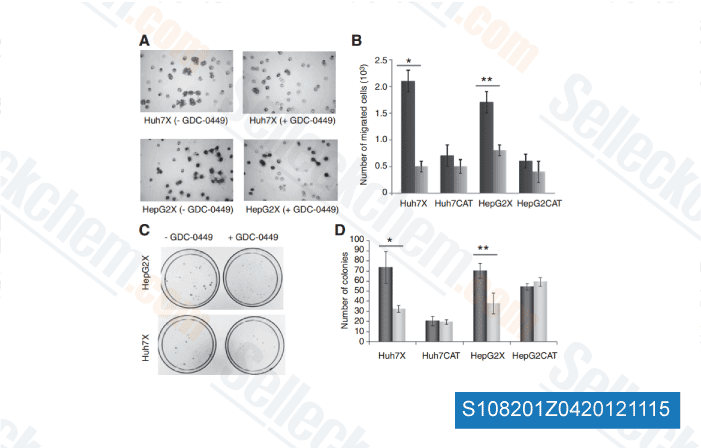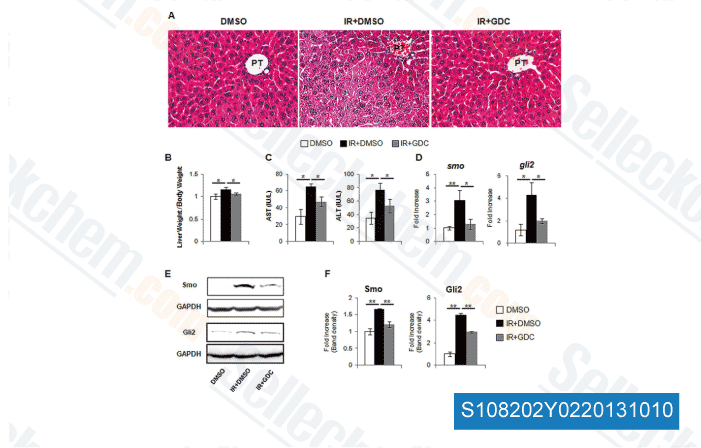|
Toll Free: (877) 796-6397 -- USA and Canada only -- |
Fax: +1-832-582-8590 Orders: +1-832-582-8158 |
Tech Support: +1-832-582-8158 Ext:3 Please provide your Order Number in the email. |
Technical Data
| Formula | C19H14Cl2N2O3S |
|||
| Molecular Weight | 421.3 | CAS No. | 879085-55-9 | |
| Solubility (25°C)* | In vitro | DMSO | 84 mg/mL (199.38 mM) | |
| Water | Insoluble | |||
| Ethanol | Insoluble | |||
|
* <1 mg/ml means slightly soluble or insoluble. * Please note that Selleck tests the solubility of all compounds in-house, and the actual solubility may differ slightly from published values. This is normal and is due to slight batch-to-batch variations. * Room temperature shipping (Stability testing shows this product can be shipped without any cooling measures.) |
||||
Preparing Stock Solutions
Biological Activity
| Description | Vismodegib (GDC-0449) is a potent, novel and specific hedgehog inhibitor with IC50 of 3 nM and also inhibits P-gp with IC50 of 3.0 μM in a cell-free assay. | ||
|---|---|---|---|
| Targets |
|
||
| In vitro | GDC-0449 targets the Hedgehog signaling pathway, blocking the activities of the Hedgehog-ligand cell surface receptors PTCH and/or SMO and suppressing Hedgehog signaling. GDC-0449 prevents multiple ATP-binding cassette (ABC) transporters. GDC-0449 also blocks ABCG2, Pgp, and MRP1-important ABC transporters associated with MDR. GDC-0449 is a potent inhibitor of ABC transporters, ABCG2/BCRP and ABCB1/Pgp, and is a mild inhibitor of ABCC1/MRP1. In ABCG2-overexpressing HEK293 cells, GDC-0449 increases retention of the fluorescent ABCG2 substrate BODIPY and resensitizes these cells. In Madin-Darby canine kidney II cells engineered to overexpress Pgp or MRP1, GDC-0449 increases the retention of calcein-AM and resensitizes them. GDC-0449 also resensitizes human non-small cell lung carcinoma cells NCI-H460/par and NCI-H460/MX20, which overexpress ABCG2 in response to SN-38. The IC50 values of GDC-0449 for prevention of ABCG2 and Pgp are about 1.4 μM and 3.0 μM, respectively. [2] GDC-0449 alters intracellular Ca2+ homeostasis and inhibits cell growth in resistant lung cancer cells. [3] |
||
| In vivo | GDC-0449 has been used to treat medulloblastoma in animal models. [2] GDC-0449 prevents the growth of primary pancreatic xenografts without non-specifically inhibiting pancreatic cell proliferation. Oral dosing of GDC-0449 causes tumor regressions in the Ptch(+/-) allograft model of medulloblastoma at doses ≥25 mg/kg and tumor growth inhibition at doses up to 92 mg/kg dosed twice daily in two ligand-dependent colorectal cancer models, D5123, and 1040830. Analysis of Hh pathway activity and PK/PD modeling reveals that GDC-0449 inhibits Gli1 with a similar IC50 in both the medulloblastoma and D5123 models (0.165 μM and 0.267 μM, respectively). Pathway modulation is linked to efficacy using an integrated PK/PD model revealing a steep relationship where > 50% of the activity of GDC-0449 is associated with >80% repression of the Hh pathway. [4] |
Protocol (from reference)
| Cell Assay: |
|
|---|---|
| Animal Study: |
|
References
Customer Product Validation

-
Data from [Cancer Res, 2014, 72, 5912-20]

-
Data from [Gut, 2013, 62, 299-309]

-
Data from [Cancer Res, 2013, 72, 5912-20]

-
Data from [Data independently produced by PLoS One, 2013, 8, e74141]
Selleck's Vismodegib (GDC-0449) has been cited by 224 publications
| OLIG2 mediates a rare targetable stem cell fate transition in sonic hedgehog medulloblastoma [ Nat Commun, 2025, 16(1):1092] | PubMed: 39904987 |
| The O-glycosyltransferase C1GALT1 promotes EWSR1::FLI1 expression and is a therapeutic target for Ewing sarcoma [ Nat Commun, 2025, 16(1):1267] | PubMed: 39894896 |
| GPR137-RAB8A activation promotes ovarian cancer development via the Hedgehog pathway [ J Exp Clin Cancer Res, 2025, 44(1):22] | PubMed: 39856733 |
| Spatially organized tumor-stroma boundary determines the efficacy of immunotherapy in colorectal cancer patients [ Nat Commun, 2024, 15(1):10259] | PubMed: 39592630 |
| Basal-to-inflammatory transition and tumor resistance via crosstalk with a pro-inflammatory stromal niche [ Nat Commun, 2024, 15(1):8134] | PubMed: 39289380 |
| Programmed BRD9 Degradation and Hedgehog Signaling Activation via Silk-Based Core-Shell Microneedles Promote Diabetic Wound Healing [ Adv Sci (Weinh), 2024, 11(45):e2404130] | PubMed: 39413023 |
| Identification of a distal enhancer regulating hedgehog interacting protein gene in human lung epithelial cells [ EBioMedicine, 2024, 101:105026] | PubMed: 38417378 |
| Cellular remodeling and JAK inhibition promote zygotic gene expression in the Ciona germline [ EMBO Rep, 2024, 25(5):2188-2201] | PubMed: 38649664 |
| Illuminating Dark Chemical Matter Using the Cell Painting Assay [ J Med Chem, 2024, 10.1021/acs.jmedchem.4c00160] | PubMed: 38687818 |
| Obg-like ATPase 1 exacerbated gemcitabine drug resistance of pancreatic cancer [ iScience, 2024, 27(6):110027] | PubMed: 38883822 |
RETURN POLICY
Selleck Chemical’s Unconditional Return Policy ensures a smooth online shopping experience for our customers. If you are in any way unsatisfied with your purchase, you may return any item(s) within 7 days of receiving it. In the event of product quality issues, either protocol related or product related problems, you may return any item(s) within 365 days from the original purchase date. Please follow the instructions below when returning products.
SHIPPING AND STORAGE
Selleck products are transported at room temperature. If you receive the product at room temperature, please rest assured, the Selleck Quality Inspection Department has conducted experiments to verify that the normal temperature placement of one month will not affect the biological activity of powder products. After collecting, please store the product according to the requirements described in the datasheet. Most Selleck products are stable under the recommended conditions.
NOT FOR HUMAN, VETERINARY DIAGNOSTIC OR THERAPEUTIC USE.
